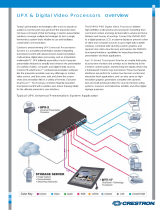Page is loading ...

Network Player
Product Guide V1.3
Before operating the software, please read this manual thoroughly and retain it for
future reference.

Revision History
REVISION DAT E DESCRIPTION
1.0 Dec 20, 2005 1. Initial draft.
1.1 June 15, 2006 1. Modified Media Format Supported
1.2 Sep 22, 2006 1. Added warning message to restrict any
modification from users
1.2a Nov 10, 2006 1. Modified software specification
2. Added port forwarding in NAT section
1.3 Jan 24, 2007 1. Change from Media Signage to Network
Player

Introduction
About the product
Network Player is a powerful engine that drives revenue-generating Digital Signage solution. MSO is
equipped to handle high-quality media of video and graphics. Using LAN or WLAN, MSO transmits
and receives data over wired or wireless connections.
Network Player BOX*
1
Integrated Display (7”)
Integrated Display (15” or bigger size)
1
The LED in the front side of Network Player BOX turns to red when power cable is connected and
the system is booting up. The LED turns to yellow when the system finishes boot-up process and starts
playing media contents

Warning: Please contact our technical support if you encounter any abnormal
situation. DO NOT open the unit and do any modification to components of any
kind.
Network Player Specification
Hardware Specification
Network Player BOX / Integrated Display 15” or bigger size
Core Processor
RISC based media processor
Media Decoding
H/W MPEG decoding Engine
Internal Storage
Compact Flash -512MB (bigger size or HDD as optional)
USB Port
USB 2.0 port for Flash Drive storage device
Operating Temp
0 to 50°C, Humidity 5-85% @ 50°C
Network
10/100 Base T Ethernet (RJ-45)
802.11b/g miniPCI for wireless LAN (optional)
Network Player BOX
Integrated Display
Video Outputs
DVI-I (can be converted into
VGA)
S-Video
Composite
DVI-I
Network Player BOX Integrated Display
Audio
N/A
Stereo 2W Speaker
Network Player BOX Integrated Display
Power Supply
12V DC input 12V DC input
Network Player BOX Integrated Display
Power Consumption
Approx. 5W Varies
Integrated Display (7”)
Core Processor
RISC based media processor
Media Decoding
H/W MPEG decoding Engine
Internal Storage
Compact Flash - 512MB (bigger size as optional)
Audio
Stereo 2W x2 Speaker
Network
10/100 Base T Ethernet (RJ-45)

802.11b/g miniPCI for wireless LAN (optional)
Power Supply
12V DC input
Power Consumption
15 W typical, normal operation
Operating Temp
0 to 50°C, Humidity 5-85% @ 50°C
Software Specification
Network Protocol Support: HTTP, TCP/IP
WLAN: IEEE 802.11b/g
Package Contents
z One Network Player
z One power Cord
z One DC power adapter
z DVI-VGA cable
z User Manual CD
z AV-RCA Cable (optional)
z S-Video Cable (optional)
z RS232 Cable (optional)
z Audio Cable (optional)
z Remote Control with 3V battery (optional)
Device Management
After installing the Network Player, you need the followings to configure and manage your media
content:
z One computer with Media Signage Organizer installed
z Microsoft Windows 2000/XP operating system

Connection Ports
Network Player BOX
Integrated Display (7”)
Integrated Display (above 7”)
DC power
DVI-I
S-video
Com
p
osite
A
udio-out
USB 2.0 * 2
LAN
RS232
DVI-I
DC power
A
udio-out
USB 2.0 * 2
LAN
DC power
LAN

Connecting Cable
Network Player BOX
1. Choose the video output (DVI/S-video/Composite) you would like to use and connect the cable.
Connect another end to your monitor.
2. Connect audio cable (optional).
3. Configure network (optional)
a. Connect Ethernet cable to Network Player LAN port
b. Connect another end of Ethernet cable to a hub
c. Connect Ethernet cable to your computer with MSO installed
d. Connect another end of Ethernet cable to a hub
4. Connect RS232 cable (optional).
5. Plug the DC end of the power adapter into the power connector of the Network Player; then, plug
the AC end to an electrical outlet. The Network Player is powered up immediately.
Integrated Display
Please do step 3 to step 5 above accordingly.

Getting Started
z Install MSO, and set your own password.
z Define a new group and create a new client name.*
2
z Use a Cross-over LAN cable to connect your PC to MS one-to-one to do the set-up.
z Server IP change:
In your XP/2000: Local Area Connection → Internet Protocol → (TCP/IP) → Setup IP
address to 192.168.0.xxx
z Client IP:
Factory default IP for every MS is 192.168.0.128
Ask you MIS to get an available fixed private IP
Change the IP address by MSO “Network Config”.
You may use DOS command to check if you can successfully “ping” to the MS unit.
2
Refer to MSO user manual CD for more details.
Default IP address for every MS unit:
192.168.0.128
Default Subnet Mask: 255.255.255.0
Therefore, the IP address of your
server PC has to be 192.168.0.XXX in
order to connect to the MS unit.

Media Format Supported
Text message/Picture Format
Type Support Format File extension
Graphics/
Pictures
JPEG file
24bit-Bitmap file
.jpg
.bmp
Message/ Text ASCII Text file
.txt
.jpg
Video
Type Support Format File extension
MPEG1 (VCD file)
Support Format
Video Data
rate*
3
Up to 10.0 Mbps
Audio
codec
Max. audio data rate: 384 Kbps
MPEG1-Audio-Layers II and III(MP3)
*PCM not supported
.mpg
.dat
Video
(16:9 &4:3)
MPEG2 MP@HL
Multi-frames: Max. 480p or 576p
Support Format
Video Data
rate
Up to 6.0 Mbps
Audio
codec
Max. audio data rate: 384 Kbps
MPEG1-Audio-Layers II and III(mp3)
*PCM not supported
.vob
.mpg
.mpeg
.m2p
3
If data rate is higher than limitation, a lag might happen when playing video

Video
(16:9 & 4:3)
MPEG4
Multi-frames: Max. 480p or 576p
Support Format*
4
Video Data
rate
Up to 4.0 Mbps
Audio
codec
Max. audio data rate: 384 Kbps
MPEG1-Audio-Layers II and III(mp3)
*PCM not supported
DivX 3.11/4.x/5.x
.mpg
.avi
.divx
4
We do not support the codec of RealMedia (.rm, .rmvb) or Apple QuickTime (.mov)
/

